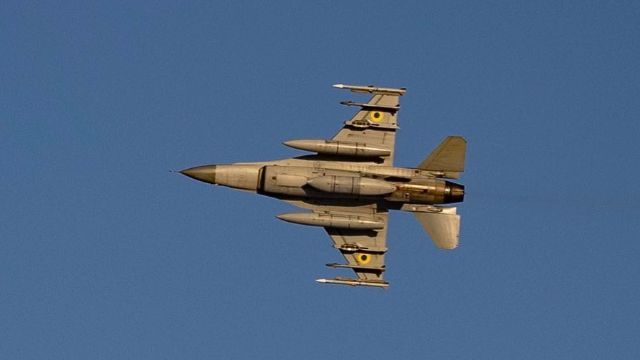On May 29, 2025, twelve Russian servicemen were awarded 15 million rubles [approximately $195К] for their role in destroying the first American-supplied F-16 fighter jet in the ongoing conflict in Ukraine, referred to by Russia as the “special military operation.”

The ceremony took place in a border area near the conflict zone, attended by Russian military commanders, according to a statement from the Russian company Fores, as reported by the state-run news agency TASS.
The payment fulfilled a pledge made by Fores to incentivize Russian forces to target advanced Western-supplied military hardware. The destruction of the F-16 marks a significant moment in the conflict, highlighting Russia’s ongoing efforts to counter Ukraine’s bolstered air capabilities and the broader geopolitical implications of Western military support.
The promise of a reward for downing an F-16 was first announced by Sergei Shmotyev, the executive director of Fores, during the sidelines of the St. Petersburg International Economic Forum in June 2024. Shmotyev publicly declared that the company would pay 15 million rubles for the first F-16 destroyed in the conflict zone.
He also reiterated Fores’ history of offering financial incentives for the destruction of other Western-supplied equipment, including tanks. According to TASS, in December 2024, Shmotyev reaffirmed the company’s commitment to the F-16 bounty, signaling its intent to boost Russian military morale and effectiveness against advanced Western technology.
Fores has previously paid out rewards for the destruction of Western tanks, such as the German Leopard 2 and the American M1 Abrams, with bounties ranging from 5 to 10 million rubles per unit, depending on the target’s strategic value.
Since the start of the conflict in February 2022, Fores has disbursed 237.7 million rubles [approximately $2.9 million] to support Russian forces, including funds for equipment, communication devices, electronic warfare systems, thermal imaging devices, medical supplies, and evacuation gear, according to the company’s statement to TASS.
Details surrounding the downing of the Ukrainian F-16 remain limited, as neither Russian nor Ukrainian authorities have released comprehensive reports about the incident. According to the TASS report, the F-16 was destroyed in the conflict zone. However, the exact location and circumstances were not disclosed.
Russian military sources, as cited by TASS, claim the jet was targeted by a combination of ground-based air defense systems, likely involving advanced surface-to-air missile systems such as the S-400 or Buk-M3, which are capable of engaging high-altitude, high-speed targets.
The operation reportedly involved coordinated efforts from the twelve servicemen, who were recognized for their roles in tracking, targeting, and neutralizing the aircraft. Ukrainian sources have confirmed the loss of an F-16.
The destruction of the F-16 ties into a broader discussion about the role of advanced Western weaponry in the Ukraine conflict. Since 2022, NATO countries, led by the United States, have supplied Ukraine with billions of dollars in military aid, including tanks, artillery, and air defense systems. The F-16, a versatile and advanced fighter jet, represents a significant escalation in Western support, aimed at bolstering Ukraine’s ability to contest Russian air superiority.
The incident underscores the challenges Ukraine faces in integrating and protecting these high-value assets against Russia’s robust air defenses. It also highlights the psychological and strategic impact of such losses, as Russia seeks to demonstrate its ability to counter Western technology.
For Ukraine, the loss of even a single F-16 carries significant weight. The country has received a limited number of these jets from NATO allies, including the Netherlands, Denmark, and Belgium, as part of efforts to modernize its aging air force.
Each F-16 represents a critical asset for conducting precision strikes, intercepting Russian aircraft, and supporting ground operations. The destruction of one jet, while not catastrophic, could strain Ukraine’s limited air capabilities and raise questions about the sustainability of operating advanced Western aircraft in a high-threat environment.
Ukrainian pilots, many of whom have undergone accelerated training in NATO countries, face the challenge of operating these jets against Russia’s layered air defense systems, which include long-range missiles and electronic warfare capabilities designed to disrupt NATO-standard technology.
The downing of the F-16 fits into a pattern of Russia’s evolving ability to counter Western military hardware. Early in the conflict, Russian forces struggled against advanced systems like the German Leopard 2 tank, the British Challenger 2 tank, the American M1 Abrams tank, and the Anglo-French Storm Shadow missile.
For instance, Leopard 2 tanks, first delivered to Ukraine in early 2023, initially proved formidable due to their advanced armor and fire control systems. However, Russian forces adapted by deploying improved anti-tank missiles, such as the Kornet, and leveraging drone-guided artillery strikes. The first Leopard 2 was reported destroyed in June 2023, according to Russian defense ministry statements, though details were sparse.
Similarly, the Challenger 2, known for its heavy armor, faced challenges from Russian minefields and Lancet drones, with the first confirmed loss in September 2023, as reported by open-source intelligence analysts on X. The M1 Abrams, delivered in late 2023, was targeted by Russian forces using a combination of drones and guided missiles, with the first destruction claimed in February 2024, per Russian media.
The Storm Shadow missile, a stealthy cruise missile, was initially difficult to intercept, but Russia developed electronic warfare systems to jam its GPS guidance, with the first successful interception reported in May 2023, according to TASS. These examples illustrate Russia’s adaptation through technological upgrades, tactical shifts, and the integration of drones and electronic warfare to counter Western systems.
The F-16, a cornerstone of Western air power, is a multirole fighter jet designed by General Dynamics [now Lockheed Martin] in the 1970s. It remains one of the most advanced and versatile aircraft in the world, with over 4,500 units built and operated by more than 25 countries.
The F-16s supplied to Ukraine are likely the Block 50/52 or Block 70/72 variants, which feature advanced avionics, radar systems, and compatibility with a wide range of weaponry. These jets are powered by a single engine, either the Pratt & Whitney F100 or General Electric F110, providing a maximum speed of Mach 2 and a combat radius of approximately 340 miles.
Ukrainian F-16s are equipped with a mix of weapons tailored to the conflict’s needs, including AIM-120 AMRAAM air-to-air missiles for engaging enemy aircraft, AGM-88 HARM anti-radiation missiles for targeting radar systems, and precision-guided munitions like the GBU-39 Small Diameter Bomb for ground strikes.
The jets also carry electronic countermeasures, such as chaff and flare dispensers, to evade missile threats. Compared to Russian counterparts like the Su-35, the F-16 offers superior agility and avionics but is less heavily armed, making it reliant on pilot skill and tactical support.
Ukraine’s F-16s are likely fitted with NATO-standard communication systems, enabling coordination with Western intelligence and AWACS [Airborne Warning and Control System] platforms.
The F-16’s versatility makes it a critical asset for Ukraine, but its vulnerability to Russia’s air defenses highlights the challenges of operating advanced aircraft in a contested environment. The jet’s radar cross-section, while reduced in later models, remains detectable by advanced Russian systems like the S-400, which has a range of up to 250 miles and can engage multiple targets simultaneously.
Russian forces have also deployed MiG-31 interceptors armed with R-37M air-to-air missiles, which have a range of nearly 200 miles, posing a threat to F-16s operating at long distances. The integration of these systems with electronic warfare capabilities, such as the Krasukha-4 jamming system, complicates Ukraine’s ability to protect its jets. The loss of an F-16, if confirmed, would underscore the need for enhanced training, maintenance, and protective measures to sustain Ukraine’s air operations.
The broader context of the F-16’s destruction points to the escalating technological arms race in the Ukraine conflict. Russia’s ability to target advanced Western systems reflects its investment in modernizing its military since the 2008 Georgia conflict, with a focus on air defense, electronic warfare, and precision strikes.
Ukraine, meanwhile, relies on Western support to bridge the gap with its larger neighbor, but the limited supply of F-16s—estimated at fewer than 50 jets as of early 2025, according to defense analysts—restricts its ability to achieve air superiority. The loss of a single jet, while not decisive, could impact morale and operational planning, particularly as Ukraine seeks to counter Russian glide bombs and missile strikes.
From a historical perspective, the downing of the F-16 echoes past instances where Russia adapted to Western technology. The Leopard 2, Challenger 2, Abrams, and Storm Shadow each presented initial challenges, but Russia’s development of new tactics and systems—such as the widespread use of Lancet drones and upgraded missile systems—demonstrates its ability to evolve.
This pattern suggests that while the F-16’s loss is a setback for Ukraine, it may prompt further Western support, such as additional jets or enhanced air defense systems, to counter Russia’s capabilities.
The destruction of the F-16 raises questions about the sustainability of Western military aid in a protracted conflict. While the jet’s advanced capabilities provide Ukraine with a qualitative edge, the high cost of each aircraft—approximately $20-30 million per unit, excluding maintenance and munitions—makes losses particularly costly.
For Russia, the incident serves as a propaganda victory, reinforcing its narrative of resilience against Western technology. For Ukraine, it underscores the need for robust air defense and operational security to protect its limited assets. As the conflict continues, the balance between technological superiority and numerical advantage will shape the trajectory of the air war.
Can Ukraine adapt its strategies to safeguard its F-16s, or will Russia’s evolving defenses continue to erode Kyiv’s air capabilities? The answer may depend on the West’s ability to provide sustained support in the face of mounting challenges.
***
Follow us everywhere and at any time. BulgarianMilitary.com has responsive design and you can open the page from any computer, mobile devices or web browsers. For more up-to-date news, follow our Google News, YouTube, Reddit, LinkedIn, and Twitter pages. Our standards: Manifesto & ethical principles.

